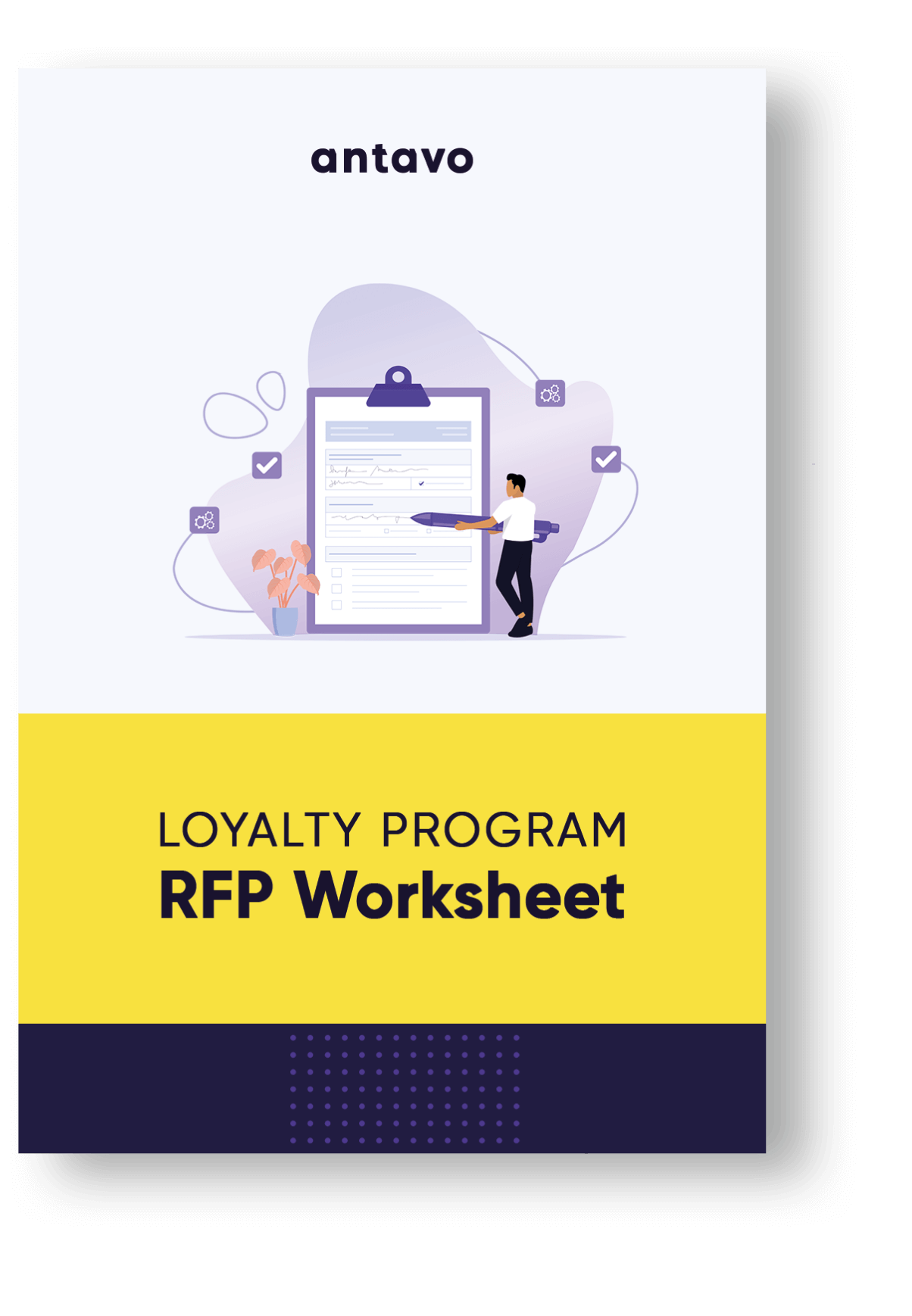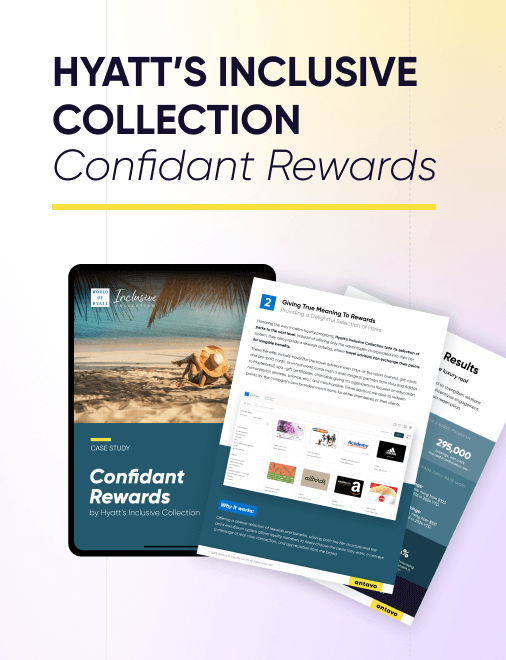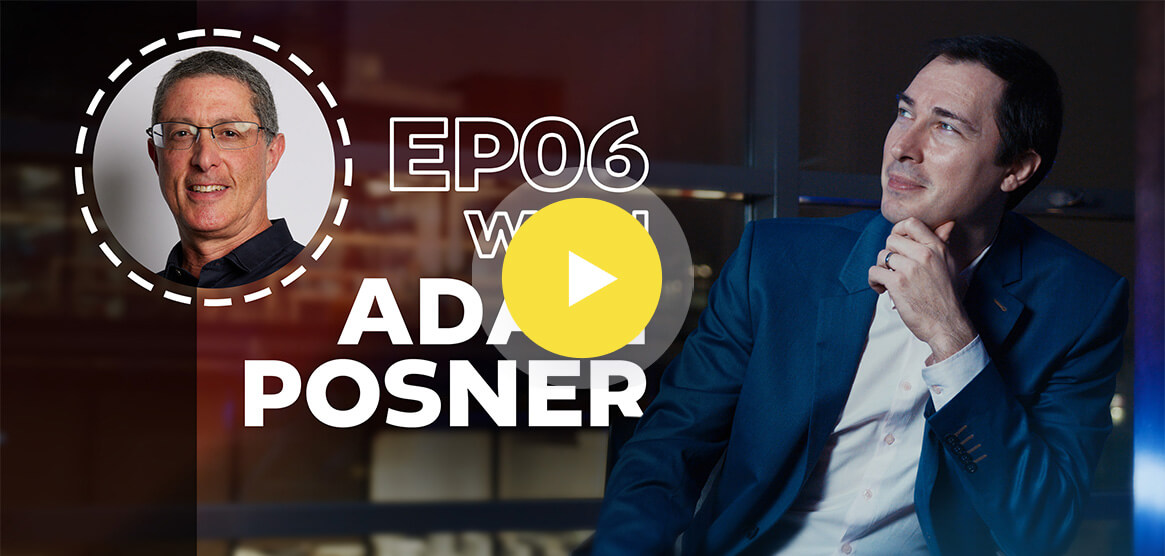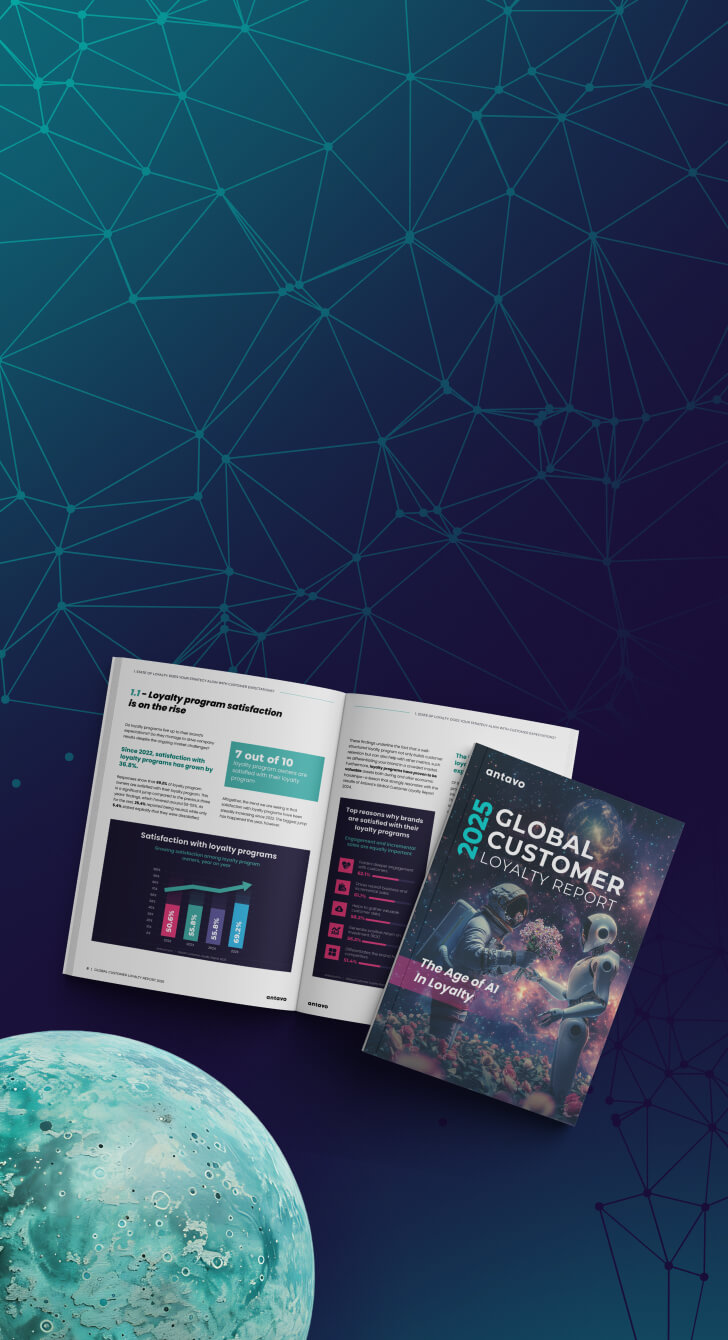Our expert guest for the sixth episode of the Loyalty Stories podcast is a ‘Loyalty Royalty’: Adam Posner, Founder and CEO of The Point of Loyalty.
The interview for this podcast has been a valuable source for Antavo’s Global Customer Loyalty Report 2024. Make sure to download it for over 30 statistics on loyalty program trends.
During today’s episode, Adam tells us all about why the IKEA Family and Club Rip Curl programs are dear to him. He also describes which aspects elevate the Childcare Saver program to the top of his “most-proud-of” leaderboard. We also go into more detail about current industry challenges and changes (there are a few of them, no surprise there), and why loyalty programs represent actionable solutions to them.
Highlights from our conversation with Adam:
- 3 key changes on the loyalty horizon
- Disappointing trends to be careful about
- Progressive profiling is in, going all-in is out
- Tech-stack vendor specs and who’s making all the decisions
Learn more:
- LinkedIn profile of Adam Posner
- The Point of Loyalty website
- Link to the For Love or Money™ research
- Book a demo with Antavo’s loyalty experts
Gabor
Hi and welcome to Loyalty Stories, that is Antavo’s podcast on loyalty and loyalty programs. I am Gabor Vigh, one of the Partnership Managers at Antavo, and Antavo is a technology vendor that empowers loyalty programs all over the world. We have various great brands, such as KFC, Benefit Cosmetics, and well-known global automotive and fashion brands, airports and so on.
In this Loyalty Stories podcast, we dive into the trends around loyalty programs and customer loyalty. We talk with industry experts around the world to pick their brains to learn what’s next for loyalty programs. Today’s guest is the Founder and CEO of The Point of Loyalty, a well-known loyalty strategist, who helps brands to make more profitable revenue on their loyalty programs and loyalty programs in the ANZ region and the person inspired a lot of people to step on the path of loyalty. He is also the author of the Customer Loyalty and the Loyalty Programme Research Study “For Love or Money™”, which is now in the 16th edition of Australia and New Zealand. Please welcome Adam Posner. Hi Adam, how are you?
Adam
Yeah, Gabor, I’m fantastic here. It’s spring in Australia, and thanks for inviting me on today.
Gabor
Thank you very much for accepting our invitation Adam. Pleasure to have you here today. First of all, for the audience, can you please briefly introduce yourself?
Adam
Yeah, thanks very much. I’m the Founder and CEO of The Point of Loyalty, and I’m an independent loyalty specialist here in Australia. And I provide strategy, structure, and financial modeling and research for brands to ensure their loyalty programs are lifted out of the sea of sameness. And I also author the research study “For Love or Money™”.
So yeah, love loyalty, live loyalty, breathe loyalty and programs all day, every day. And I’m really glad to be with you today, Gabor.
Gabor
Great, great. So as you’ve been a loyalty professional Adam for a long time, I’m really keen to know what is your favorite loyalty program and why are you naming it as your favorite?
Adam
I’ve got two that I’d like to share with you. One is IKEA, IKEA family. You might’ve heard of their loyalty program around the world. And I’m a big fan of that program because they’re continuously innovating. They’re continuously looking at improving the program proposition. And it really does cover what I call the six currencies of collection that loyalty program members care about.
So they really have a transactional offering and they’ve recently launched something called the Allen Keys (Reward keys – editor’s note), which it’s like a points element. They have a great experiential offers. They know how to personalize their comms. They have a social element to it as well. And so they’re always looking at a way of improving their members’ experience. They have an insurance element. So I think it’s just a great program because it covers all the fundamentals of a proposition that members care about.
Gabor
Oh, great example. I really like IKEA family. I am a member here in the UK and I, to be honest, I really enjoy their discount on the hot dogs in the restaurant. Yeah, but it’s been a while I haven’t used them. But should check it out again.
Adam
Yeah, and that’s a very interesting comment because they not long ago did a very big campaign called the Baller campaign, the BallerCard, which was a surprise and delight, a joyalty campaign where they gave a gold card to some of their top members who got free meatballs, chicken balls and veggie balls. So, you know, you talked about their hot dogs. They also know how to deliver great communication and joyalty moments. So IKEA family is a real favourite.
Gabor
Interesting. Sounds good.
Adam
And my other one is something that a program here in Australia from called Club Rip Curl, which is a brand that I think Antavo actually looks after and how they’ve built out a program with points for interaction.
In fact, you can get points for surfing. And I think it’s absolutely brilliant now that loyalty programs can gamify and create rewards for interaction, not just transaction and, you know, doing something you love, like surfing and earning points for that. Well, isn’t that incredible that a program can move from transactions to experiences in a brand that, you know, is, I love surfing and it’s a great program.
Gabor
Thank you Adam. Yes, it is really one program that Antavo empowers and we’ve been working with Rip Curl for a while and yes, also very happy that they introduced their surf watch that enables us to collect all of this data.
Based on that data, we are able to generate leaderboards to put the surfers, the top performers on there. So then they can be honored for surfing at Rip Curl . So yeah, I find that’s one of my personal favorites as well.
Adam
Good
Gabor
And as you have rolled out lots of different loyalty programs in the past Adam, what would you say, what is that piece of work that you are the most proud of?
Adam
Yeah, there’s a program here in Australia that I worked on some time ago, and it’s quite a different category than people might expect. It’s in the childcare centers around Australia where they were looking to try and find a way to reward the parents of kids who they put into childcare. And we did a lot of work to try and uncover, instead of just having the normal points and perks and special offers, what we worked out was what was the problem we were trying to solve for.
And the problem we were trying to solve for was parents wanted to afford more days of childcare for their kids. And so ultimately we came up with a program and a strategy around a cashback program where they could earn cash back from their shopping and they could use that to put towards or save for more days in childcare. So this is a great way of solving a problem.
And the program is called Childcare Saver. And it’s just a brilliant example. And yeah, I did work on it. So maybe that’s why I say it’s brilliant. But it’s just a good example of when you’re looking at a loyalty program, don’t just do the normal. What problem are you trying to solve for and can a program help that? And Childcare Saver does that. So I’m very proud of that program and it really is helping, it’s helping its members, rather than just giving them points and perks.
Gabor
Sounds very interesting Adam, yeah. Here in the UK I know a couple of people who would have a good use of these kind of programs, having more days in childcare, yeah, brilliant. And there’s been a lot of changes going on in the loyalty space in the past couple of years. What would you say, what were the biggest changes in the loyalty space?
Adam
Well, I think what comes to mind in the more recent times is lots of loyalty programs are going through a review and a revitalization. So I feel that, you know, times are more challenging. And so the economics of loyalty programs are being looked at by the brands. And a lot of programs are either changing their benefits, sometimes they’re removing them.
But the smart programs are adding more value to their propositions for their members. So I see quite a few programs now reviewing, revitalizing, refreshing their propositions, looking at their financials, their member experience. So I’d say that’s the number one big change is that programs are going through a whole new recycle or review process.
I’d say the other area of changes is more in the area of rewards for interaction rather than transaction. And I know we spoke about it just on the other example, but I’m seeing more and more programs, you know, trying to find ways to create more experiences with rewards rather than just for transacting. And so I think that’s something that’s starting to become more and more prevalent in programs.
The last one, the number three on the big changes is in the area of privacy and data governance and how programs have to be so careful now and compliance around the use of data, the collection of data and the protection of data. So that’s another area that I’ve seen a huge change and everyone’s lifting up their professionalism around that area.
Gabor
Did anything surprise you or shock you as a change in the past?
Adam
And no, I don’t think that because I’m so close to loyalty programs every day in every way, and nothing really is an absolute surprise, except I think that, you know, some programs are slowly reducing their value to their members. Now, that’s not a surprise, but it’s a bit disappointing because you really got to be careful of the impact of changing your program proposition.
And the impact on your brand and the loyalty to your brand, because a loyalty program is a promise. It’s a promise that the brand makes to its customers and gets them to become members. And so, you know, the downstream impact of changing programs and perhaps devaluing the benefits, it does have a remarkable change to a customer’s loyalty to the brand.
So you know, the lesson there for me is that you really got to be careful with your financials when you build out your program proposition. And think not only one year, but think two, maybe three, five years ahead, where possible in building out the profitability of your program.
Gabor
Thank you Adam. And now that we talked about the past and if we look into the future, what are maybe those two main trends in loyalty that’s gonna kind of like be placed in loyalty programs in the next couple of years? What will be those two trends that are gonna really hold the market?
Adam
Okay, well, I think the aspect of data, the ask for data will be minimized. What do I mean by that? I mean, brands with loyalty programs will not try and get every piece of data at the first signup. Now that sounds like, you know, that’s obvious, but I think it’ll all be about get as minimal as possible, you know, contactable data, you know, just to sign up.
And then progressively profile. So build on the data capture rather than trying to get everything at once. And really the most important trend here is only ask for what you’re going to use. No point in asking for my date of birth if there’s no birthday offer because you’re just asking me for a piece of data that you want brand to know and profile, but what’s the benefit? What’s the value exchange? So I think the data ask will be minimized and carefully curated and progressively profiled over time.
The other trend that I’d suggest would be coming through is more niche, but what I would call retailers who have a big supplier base. So grocery, pharmacy, and various other categories like movies and shopping cities. They’ve got a big supply base of lots of brands that engage with them, and they’ll become a retail media network and an asset, especially a loyalty program will be a big asset of those brands. And they will go to their suppliers and get them engaged with their programs.
So whilst that’s quite specific, you know, a loyalty program is an owned asset, it’s an asset that delivers cash. And if suppliers want to access those loyalty customer bases, well, the brands that have those programs well nurtured, curated and cared for, and that really becomes an asset of profit for the brand.
Gabor
Great insights, thank you Adam. What do you think, how a loyalty program technology company should support these things? What are those main features that are really necessary to support these kind of innovative and modern loyalty programs?
Adam
Yeah, I think that, you know, there’s a big focus on the effectiveness of the tech stack that’s now within an organization and are they maximizing the impact of what they’ve invested in. So I think technology companies and vendors should be helping their clients maximize the use and the value derived from their technology stack.
So it’s not just a shiny new thing that you get 5% use out of. It’s how do you get 99 to 100% use and value from the technology that they’re investing in? And how do vendors help that process? Is it through the way they connect all the pieces together or is it about improving the training of the team internally to actually understand all the bells and whistles, all the aspects of using the technology stack or the solution? Is it about, you know, continuously to prove the ROI for an internal buy-in?
You know, the vendor shouldn’t necessarily just sit and forget and walk away. They’ve got to be a partner every day in every way with the platform, with the brand, you know, in order to ensure that not only does it stay there for a long time but it gets maximum use as they say you want to sweat the asset. You want to make sure you get as much use out of it as possible.
Gabor
Great, and when it comes to technology there’s always kind of like dilemma at the brand, buy or build in-house, what do you usually see there Adam?
Adam
Yeah, look, that’s very bespoke to the brand, the technology, the capability, the capacity. I see more of, you know, I guess licensing and or purchasing external, so long as, you know, all the pieces connect without too much heavy lifting internally. When a brand says, no, we’ll build our own, that’s because they’ve done an ROI or a business case based on a whole range of factors, you know, and the nuances of their business, and they feel that most probably it’s more cost effective to do it internally.
I don’t have a specific view. It’s actually got to be looked at in its relevance, as I said, capability, capacity, solution stacking, how they all connect, and the ultimate purpose. So many, many pieces of that puzzle, and I don’t have and either way, it just comes down to the specific situation.
Gabor
And when you advise brands about technologies or build in-house or these kinds of financial measures, what do you experience in the market? Who are your main stakeholders? Who is really coordinating these loyalty projects?
Adam
Yeah, that’s a really interesting question because it all starts with, you know, it’s a wider team engagement. So it’s not only the head of marketing or head of loyalty, it’s the C, you know, the chief financial officer, it’s the CTO, the technology or information people. It’s the, you know, the CEOs involved, you know, the senior people are involved, the experienced people, maybe there’s merchandise and branding.
You know, it does go across all facets of the business. But the most important aspect is to get the requirement specification signed off and agreed on. If you can get the requirement specification, so what’s the program, what’s the proposition, what’s the experience and all the elements that go in, that requirement specification document is so critical so that everybody understands the map. And when you go to the technology partners, they’re all working from the same requirement specification.
Gabor
Great. And is there anything else Adam in mind that you would like to share with the audience?
Adam
You know, I think in your current survey, you asked some interesting questions that I just wanted to talk about briefly. And one of the questions you asked was this aspect about to what extent do loyalty programs or have they helped companies overcome the challenging times?
And I just wanted to expand on that one because I see in Australia and New Zealand that loyalty programs have become a real cash producing assets, helping brands who have a program to mitigate the reduction in customer spend due to those economic challenges. And those companies who actually carefully curate and nurture their loyalty programs have access to this asset of known and consented members who are directly contactable.
So it provides a real platform for direct and inferred segmentation for personalized communication to actually motivate and change purchase behavior. So a loyalty program really is like a cash cow, if I can say that, if it’s managed very carefully, curated for the long term. And I just wanted to add that extra aspect to some of the questions you asked in your survey.
Gabor
Great, thank you Adam. You’re not the only one who raised this point so far, so I’m very glad to see it more and more that we shouldn’t think of loyalty as like a cost center. It can be really a profit center and also it can help the members benefit from it and also help to overcome some tough situations, especially in nowadays economical climate.
So great stuff. Thank you very much Adam for being here with us today and sharing your thoughts. I really enjoyed our conversation. Of course my favorite part was the IKEA hot dog and food and meatball stuff that you were talking about. But a professional point of view definitely when you mentioned that loyalty programs are coming through revitalization and they are brands are constantly reviewing their proposition on loyalty programs.
This is, I believe, what we call in Antavo, which revamping loyalty programs. And also they are looking it through with the eyes of financials as well. And I really liked the point when you mentioned the data ask that will be minimized.
So, yes, it makes absolute sense to start small and then start building on the data capture more and more and only ask what you are going to use for. So I think it’s a very good way also to optimize other departments within the company. So yeah, thank you very much for sharing your thoughts. Be here with us.
Adam
You know, that’s a pleasure. Just on the data thing, you know, I just I feel that people say that data, data is, data is king. So my view here is data is not king. Data is not queen. Data is a whole deck of cards. And so you’ve got to look at it, you know, from that point of view, it’s not one aspect, but you’ve got to build slowly and that’s why I’m very passionate about, don’t just ask for everything.
Don’t just try and get the ace of spades right up front. You know, build slowly, build your 52 deck of cards, if that’s my analogy, build slowly, and then you’ll win, rather than just getting data for data’s sake.
Gabor
Oh great, great quote great analogy as well. So thank you Adam.
And for the viewers, wherever you listen to us, be it on a podcast platform, YouTube channel or LinkedIn page, please like us, like this podcast, subscribe to our channel, so in this way you will get notified when the next episodes are out, and also tell us about your point of loyalty in the comments, tell us about what you think of this conversation on the comment section below.
And also visit antavo.com discover your next loyalty software. Don’t forget, Antavo is a next-generation loyalty program technology company, used by global brands like KFC, Benefit Cosmetics, global automotive, and fashion brands, airports all over the world.
Also, visit The Point of Loyalty’s website at thepointofloyalty.com.au or Adam’s LinkedIn page to find out more exciting details of his work. Thank you, and see you on the next one!
Bye for now.










